Traverser/Transfer Table Lines
(Page 1 of 2)
A traverser (transfer table) is a series of parallel tracks on a table that can slide from side to side, providing access to several approach lines. It’s a very useful way to insert a muilti-track fiddle yard into a very short space. These micro layout plans use the device to make possible a dellightful variety of operating patterns.
The Foggier Bottom Railway
 Jack Trollope noticed that by adding a little width to the Foggy Bottom layout, he could include a spur at the front right to conceal the traverser (transfer table) — thus producing the Foggier Bottom Railway. This plan is slightly larger than micro layout size, but we present it to demonstrate that expanding any plan’s area — by even a small amount — can generally allow increased operating possibilities as well as improved scenic potential. Foggier Bottom Rwy is 56.5″x12″ (143×30 cm) in 16.5 mm gauge. Can anyone spot where the inevitable bottleneck will occur in shunting this complex layout?
Jack Trollope noticed that by adding a little width to the Foggy Bottom layout, he could include a spur at the front right to conceal the traverser (transfer table) — thus producing the Foggier Bottom Railway. This plan is slightly larger than micro layout size, but we present it to demonstrate that expanding any plan’s area — by even a small amount — can generally allow increased operating possibilities as well as improved scenic potential. Foggier Bottom Rwy is 56.5″x12″ (143×30 cm) in 16.5 mm gauge. Can anyone spot where the inevitable bottleneck will occur in shunting this complex layout?
 Pier 39 Yard takes its inspiration from many small yards up and down the east coast of the United States, where railroads brought freight cars across a river or bay by ferry and left them to be unloaded into wagons and trucks. Often, these yards were not otherwise connected to the rail network … the only access was by the ferry (offstage in this design).
Pier 39 Yard takes its inspiration from many small yards up and down the east coast of the United States, where railroads brought freight cars across a river or bay by ferry and left them to be unloaded into wagons and trucks. Often, these yards were not otherwise connected to the rail network … the only access was by the ferry (offstage in this design).
The transfer table (traverser) fiddle yard provides a runaround capability and is hidden inside a waterfront warehouse building that is the source of an endless variety of frieght cars. The paved team yard provides an open air venue to transfer goods from rail to horse cart, delivery van, or 18-wheeler — depending on the era you’re modeling! Very small switch engines, either steam or diesel, work the yard.
As drawn, the layout is designed for railroad cars that are no longer than 40 feet. With its prototypical space-saving double-slip switch this tiny yard can hold a total of 16 cars! Scenery should show waterfront scenes, and modeling challenges might include a working gantry crane on the team track in the front, and locomotive servicing facilities alongside one of the spurs. All in all, Pier 39 Yard provides a large amount of operating fun in a very tiny space.
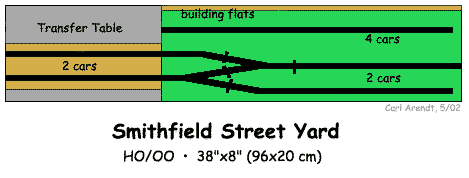
 Smithfield Street Yard is a smaller version of my Foggy Bottom plan, and it’s a layout that has actually been built by Jack Trollope (photo at left). It’s one of the smallest multi-turnout layouts in this collection, but it offers excellent operating capability.
Smithfield Street Yard is a smaller version of my Foggy Bottom plan, and it’s a layout that has actually been built by Jack Trollope (photo at left). It’s one of the smallest multi-turnout layouts in this collection, but it offers excellent operating capability.
The transfer table (traverser) does double duty as a runaround loop and as access to the long siding at the rear, which functions as the Smithfield industrial switching district. Basically, freight cars are received and sorted in the little yard in front, then delivered to the industrial customers at the rear via the transfer table.
Scenically the traverser can be concealed within a building shell as in Pier 39 (above), disguised as a car ferry (paint the baseboard dark greenish brown in this area), or simply left out in the open to represent a prototype table often used to access locomotive and car repair shops.
Switch lists can be generated in a number of ways to direct the placement of cars, and shunting challenges can become very complex on this tiny layout, less than a meter long!
Shortover Yard — a Seriously Compact Layout!
 Jack Trollope was triggered to design Shortover Yard as a result of hearing about a design competition for layouts that fit on an A3 piece of paper — 11.7″x16.5″. Intrigued, he cut the sheet down the middle, joined the ends, and built an HO layout measuring 5.8″x33″ (14.8 x 84 cm). It’s one of the smallest layouts in this Gallery!
Jack Trollope was triggered to design Shortover Yard as a result of hearing about a design competition for layouts that fit on an A3 piece of paper — 11.7″x16.5″. Intrigued, he cut the sheet down the middle, joined the ends, and built an HO layout measuring 5.8″x33″ (14.8 x 84 cm). It’s one of the smallest layouts in this Gallery!
It’s designed as a Transfer Yard in a generic American City, transferring cars between several railroads — though with a change of rolling stock it could be anywhere in the world. A single-track traverser joins three spurs in the yard — there are no track switches. Challenging operations can be programmed by randomly selecting cars to be moved and their destinations, perhaps by drawing tokens or cards from a hat.
The layout is arranged for front viewing and operation from the rear, as it’s intended for use at exhibitions. Jack is still in the process of building it, as the work-in-progress photos show. Though there are many details still to be added, the layout is starting to look good and to run well. A marvelous design — and more proof that everyone has room for a layout! In N scale, Jack reckons this layout would occupy about 4″x24″!
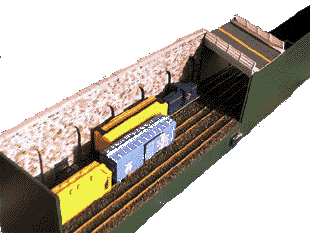
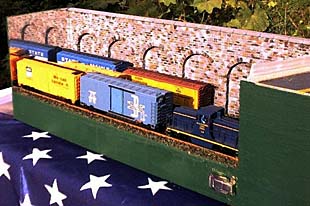
Deep in the Georgia woods…
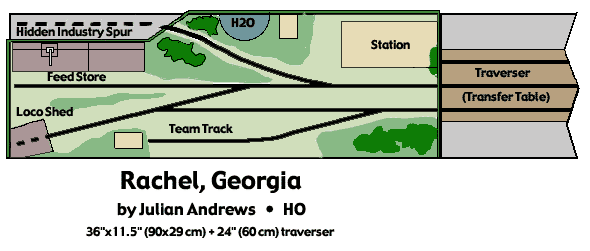 Julian Andrews lives in southwestern England, and he has produced a micro layout called Rachel, Georgia that is straight out of Lucius Beebe’s “Mixed Train Daily.” You can smell the piney woods at this little rural terminus of the Georgia Western, a fictitious shortline operating in 1959.
Julian Andrews lives in southwestern England, and he has produced a micro layout called Rachel, Georgia that is straight out of Lucius Beebe’s “Mixed Train Daily.” You can smell the piney woods at this little rural terminus of the Georgia Western, a fictitious shortline operating in 1959.
Julian uses a three-track traverser or transfer table as a staging yard and to complete the runaround facilities. Short mixed trains enter through the trees and reach the station almost immediately. The passenger coach can be cut off at the platform while the freight, piloted by the line’s two-truck Shay or GE 70-tonner, is switched in the spurs. A siding ducks off into the woods — its mission is your call, perhaps to serve a paper mill, or a logging landing for loblolly pine, or even a rural cannery. A feed store and team track each have a spur that requires shunting. So things are busy at Rachel until the loco ties down for the night in the loco shed.
Julian has created an evocative, beautifully detailed micro layout — set in a country 2,000 miles from home! To whet your appetitie, here are a few photographs, taken by Steve Bennett at the layout’s first public appearance in early October 2002.
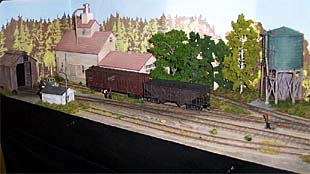
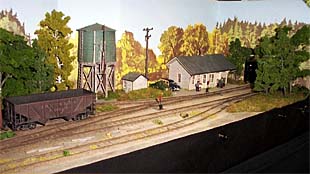
Continue to Page 2 of ‘Traverser/Transfer Table Lines”